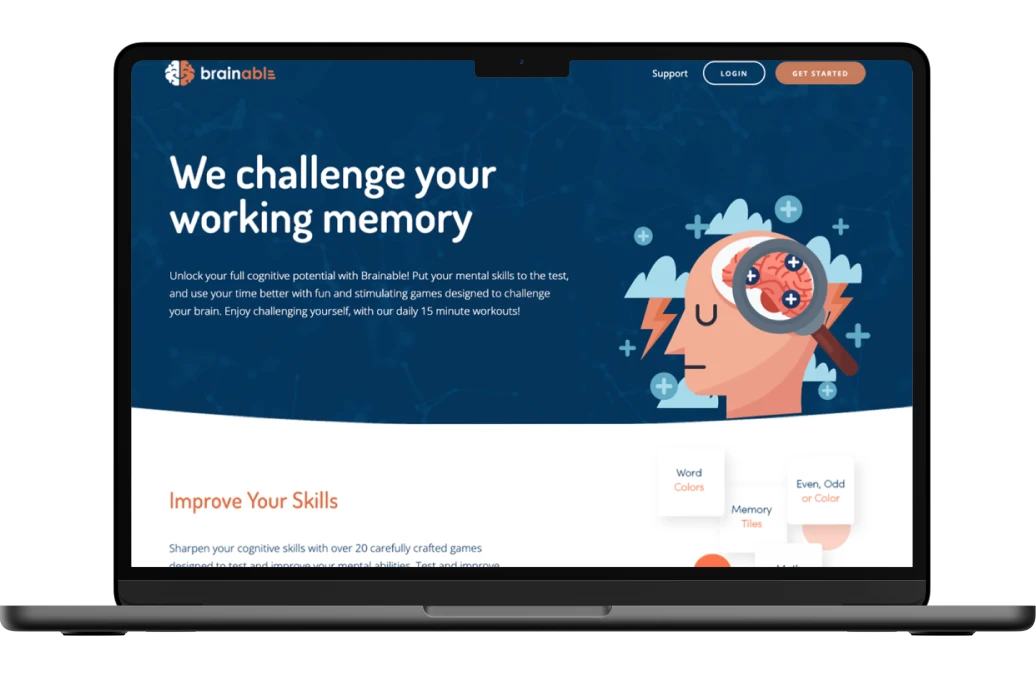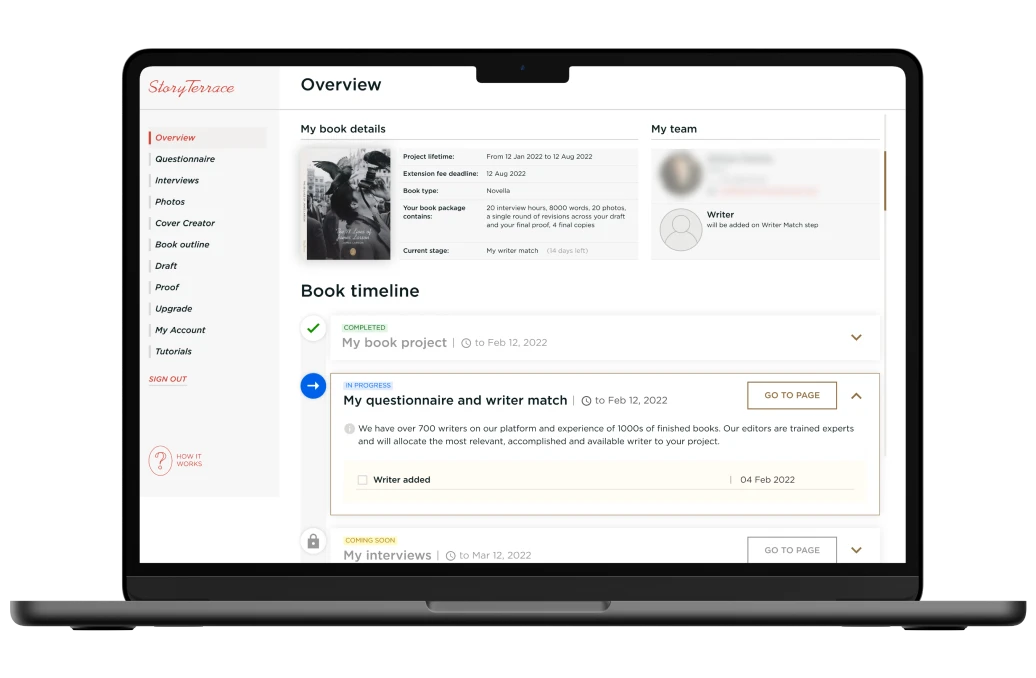Are you interested in cross-platform app development? This article is for you: we review all key characteristics of this technology here.
Developing products for multiple platforms isn’t easy. Operating systems such as iOS, Android, Windows, macOS, and Linux have unique characteristics requiring code adjustment for functioning. A common development method is focusing on independent app versions for all platforms. While such a method potentially ensures a high quality of an app due to it being optimized for a specific platform, it also has a major downside: the approach is expensive and time-consuming. When you develop a product in this way, you must fund multiple separate teams and deal with unique errors for all platforms. Is there a solution to this problem? Yes, one should try out cross-platform development frameworks. They allow one to create apps with a high transferability of code. While Android and iOS may require some unique code, cross-platform tools minimize the need for it. In this article, our goal is to offer a step-by-step guide to cross-platform app development and outline the key approaches to testing the apps prepared with the use of such frameworks. You’ll learn why one should invest in this software and how to prevent errors.
What is Cross-Platform App Development?
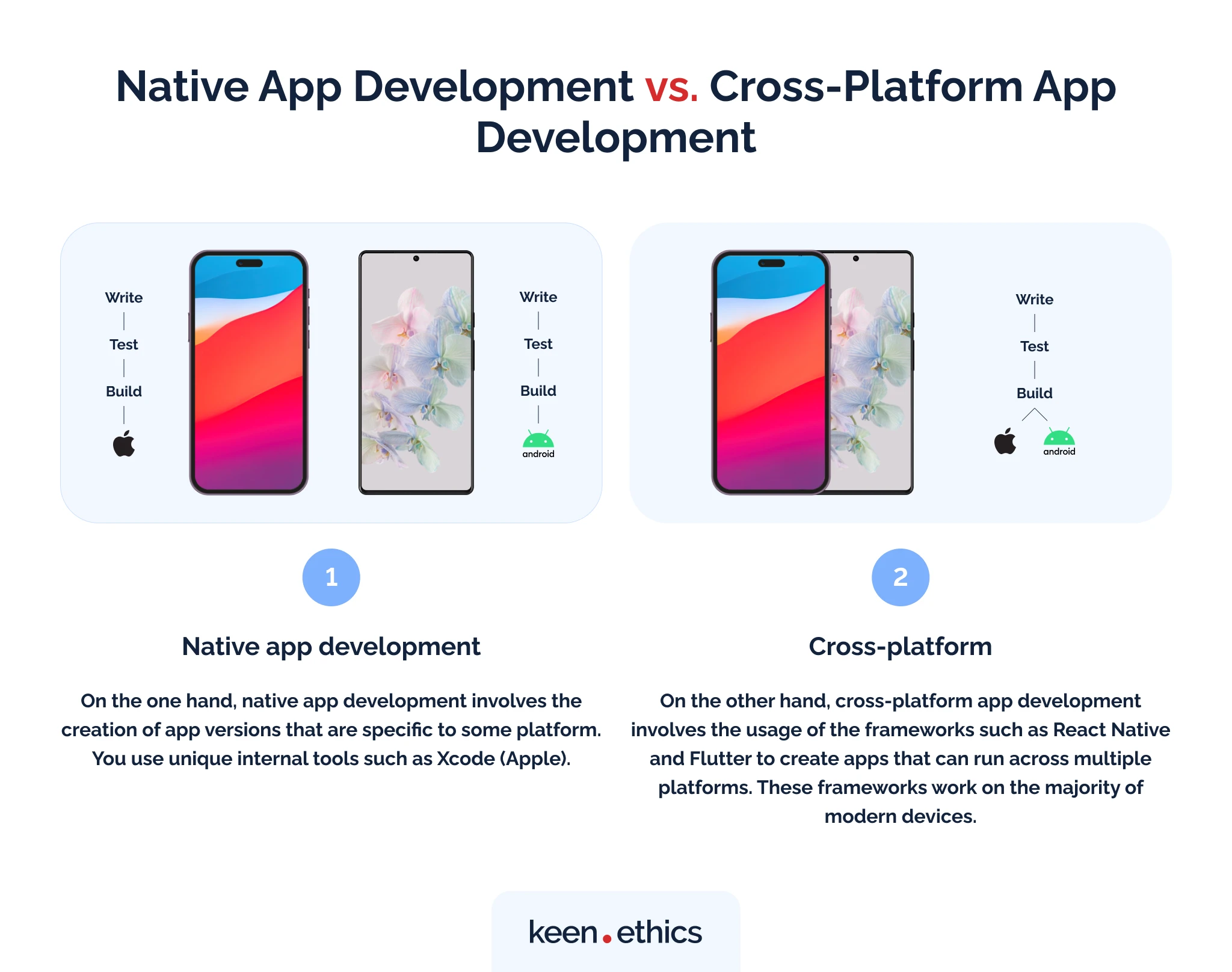
Definition of cross-platform app development
Before transitioning to issues such as testing, we must answer this question: “What is cross-platform development?” Cross-platform app development involves the use of programming platforms allowing for high transferability of code. In short, it’s about the use of development frameworks that minimize the need to adjust code for different platforms. Ideally, a cross-platform app could work on any device without other interventions. The reality is slightly less impressive: web and mobile platforms, for example, have radically different interfaces, requiring unique code to enable proper controls. Still, our experiment aimed at analyzing the cross-platform app development impact on a note-taking app shows we can expect the transferability of code above 90%. This means each platform may need only 10% of the unique code.
Native app development vs. cross-platform app development
Before we look at other aspects of the discussed topic, it’s a good idea to highlight the difference between native app development and the cross-platform approach. So, what are the key divergences of these approaches? On the one hand, native app development involves the creation of app versions that are specific to some platform. You use unique internal tools such as Xcode (Apple). This approach offers great platform integration but disrupts the ability to transfer code without major rewrites (up to 80% of the code). On the other hand, cross-platform app development involves the usage of the frameworks such as React Native and Flutter to create apps that can run across multiple platforms. These frameworks work on the majority of modern devices. Do they offer top performance? Most likely, no: some compromises are necessary to make an app work across multiple operating systems. What is crucial about such development is the minimization of development time. You no longer have to rewrite the majority of the code to port an app from iOS to Android, for example. Indeed, some changes are necessary. Nonetheless, they tend to be small in comparison to native app development.
Principles of Cross-Platform App Development
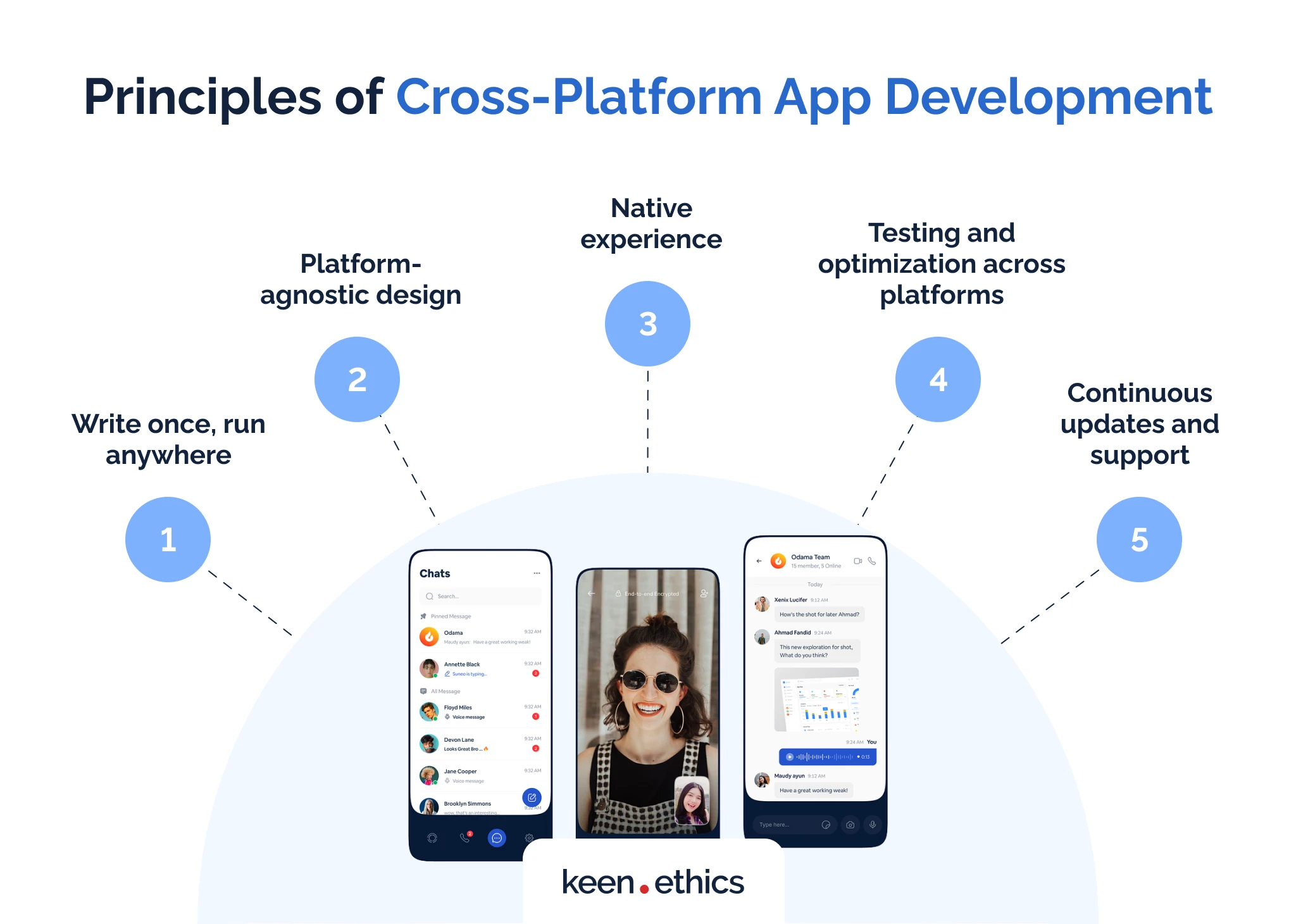
To promote an even better understanding of cross-platform development, we would like to highlight some principles necessary for this approach:
1) Write once, run anywhere: as we’ve mentioned above, the idea, in this case, is to minimize the amount of work during development. Cross-platform apps help managers save funds by minimizing the number of workers necessary for development. While reaching the ideal version of this principle is impossible, you can expect that more than 90% of the code can be reusable.
2) Platform-agnostic design: cross-platform development requires a platform-agnostic approach. The idea is to minimize any platform-specific ties. What should one focus on in such a situation? In our opinion, this involves using standard technologies, frameworks, and programming languages compatible with multiple platforms. The whole idea of cross-platform app development is to reduce the reliance on unique platform-specific technologies.
3) Native experience: app speed and great integration with the existing OS tools is essential for a high-quality user experience. In this respect, a major principle of cross-platform app development is the focus on the native-like experience. It’s far from being simple: code reusability requires some compromises. This factor is why code transferability isn’t 100% for cross-platform apps. The developers have to add unique controls for the web and mobile versions, for example, and care about the general usability of the interfaces. Cross-platform development doesn’t mean you should sacrifice usability to minimize workload.
4) Testing and optimization across platforms: cross-platform development requires thorough testing and optimization across different platforms to ensure consistent performance and behavior. It’s naive to expect that a cross-platform app would work perfectly everywhere. While the usage of common programming languages and frameworks minimizes differences, we can still expect platform-specific bugs. Why? Technologies such as Titanium SDK may have unique integration issues within iOS or Android. So, what should one do to ensure an app offers a potent experience satisfying the maximum number of users? You should conduct comprehensive testing on each platform, addressing specific issues and optimizing the code and user experience for each target platform.
5) Continuous updates and support: cross-platform development is an ongoing process. Why? Platforms evolve, new features are introduced, and bugs are discovered. This means providing continuous updates and support for an app across all key platforms is essential. Only this approach ensures compatibility and addresses issues arising from platform updates or changes. Cross-platform development is, more or less, impossible and irrational without a major investment in long-term support.
Benefits of Cross-Platform App Development
So, what are the key benefits of cross-platform app development? Let’s look at the positive interactions that can help boost your business:
1) Enhanced market reach: cross-platform app development allows you to simultaneously target multiple platforms (iOS, Android, web). In this way, you can expand your app’s potential audience and market reach. Many apps specific to iOS lose the ability to capture other markets due to the presence of inspired alternatives within them. For example, iTunes has many alternatives, such as VLC or MusicBee. FaceTime on macOS is losing to platforms such as Telegram and WhatsApp, according to Statista.
2) Reduced development time: by utilizing a single codebase, cross-platform development reduces development time as there’s no need to write separate code for each platform. Research2Guidance, an expert firm in the healthcare sphere, notes that one can expect at least a 30% reduction in the app development time with cross-platform apps. Why is this important? Using this time, you can capture a market share first or schedule more debugging tasks for certain apps.
3) Cost-effectiveness: we all know a popular saying: “Time equals money.” Most developers in the modern IT market work at hourly rates. If you save development time with cross-platform development tools, the developers will receive reduced payment for their services. This doesn’t mean we put people out of work, of course: instead, they’ll have more time for other projects, obtaining an opportunity to get more experience. You also decrease the number of people working on a project. There’s a reduced need for specialists who focus on one platform. With cross-platform development, you can save costs by minimizing the need for dedicated teams. All this can lead to major long-term cost reductions for all involved individuals. According to Yojji, a Ukrainian development company, their internal statistics show cost reduction of up to 30% (equal to time savings) if cross-platform development tools are used.
4) Code reusability: as we all know by now, cross-platform app development enables one to use a more or less unified codebase for product creation across multiple platforms. The ability to reuse code on different platforms streamlines the development process, improves maintainability, and reduces the chances of introducing bugs. Why develop the same feature three times if you can do this once?
5) Consistent user experience: if you’ve ever used some word processors such as Microsoft Word on the desktop, web, and mobile, one thing was likely easy to notice: they tend to be extremely different and inconsistent. This issue is an outcome of using diverging tools for development. When you build cross-platform apps, this problem becomes less prominent. Cross-platform frameworks provide tools and libraries that help maintain a consistent user experience across platforms. After all, you use a singular code base for development.
6) Simplified updates and maintenance: the problem with native apps is that their update process is costly and inconsistent. You have to maintain two or more teams. Sometimes, features don’t arrive on one of the platforms as fast as on the others. It’s common for iOS or Android apps to get some functions first. Cross-platform app development solves this problem once and for all. Within cross-platform apps, updates and maintenance tasks can be performed more efficiently since changes to the codebase can be propagated across all platforms simultaneously. Few things are as potent as a unified codebase for an app.
Challenges in Cross-Platform App Development
Building cross-platform mobile apps makes sense. Still, it’s useful to know about the potential negatives of such development, too.
Key challenges
- Platform limitations: different platforms have their unique limitations and capabilities. This may require workarounds or compromises when developing cross-platform apps. While cross-platform development tools work across a maximum number of devices, they may encounter long-term compatibility issues.
- Performance issues: the key benefit of native apps is that they use a code base optimized for a specific platform. Cross-platform frameworks have to include functions targeting multiple device types. This means they can be ‘heavier’ than native tools regarding code complexity. In such conditions, you can expect more issues with performance on cross-platform apps. This doesn’t mean they won’t work well. What this means is that they will require more effort for optimization. PlayStation 4 and 5 exclusive games look so well because the developers have access to the in-depth features of these systems. iOS and macOS exclusive apps work great because they’re optimized for particular hardware.
- User experience consistency and platform compatibility: we’ve mentioned the consistency of user interfaces as a major benefit of cross-platform systems in the preceding sections. From the standpoint of developers, however, this can be a major problem. What’s wrong in the presented case? Maintaining a consistent user experience across multiple platforms is challenging due to differences in UI/UX guidelines, navigation patterns, and platform-specific design elements. The developers must possess advanced knowledge of platform idiosyncrasies to guarantee consistent experience on devices with different input methods. Taking different screen sizes into consideration is a major concern too.
- Limited access to platform-specific features: cross-platform frameworks may not provide full access to certain platform-specific features. If we compare native and cross-platform apps with similar functions, it’s likely that native ones will be more advanced. Final Cut Pro has been a key app for video editing during the preceding decade. Only now, apps such as Davinci Resolve manage to outcompete it.
- Learning curve and expertise: cross-platform development tools tend to be complex and require many hours to understand their internal functioning. The integration with different devices may be an especially problematic feature. This means finding a good specialist for developing apps via cross-platform tools is a complex process. One has to possess advanced expertise to work well with such platforms.
Overcoming the presented challenges
What should you do to overcome the challenges outlined above? In our opinion, the key factor in this case is experience and thorough testing. How to make cross-platform apps that work as well as native ones? Firstly, you should hire an experienced team. We at Keenethics have been working in this field for more than eight years. Secondly, investing in testing and thorough UI/UX audits is vital. The more tests you perform for your app, the better.
Related Services
MOBILE APP DEVELOPMENT SERVICES
Popular Cross-Platform Frameworks
Do you want to learn as much as possible about popular cross-platform frameworks? In this section, we offer the key insights for our readers:
Development frameworks for frontend and backend
Frontend platforms
How to make a cross-platform app? Take a look at the existing platforms to understand what tools one should use:
- Titanium: Titanium allows developers to build native-like mobile apps using JavaScript. It provides a single JavaScript codebase that compiles to native code for multiple platforms, including iOS and Android. Titanium supports platform-specific APIs and delivers a rich set of UI components. The key advantage of the platform is its high productivity and good transferability (PhoneGap is the only competitor regarding the second aspect). And what about downsides? It’s less popular than Xamarin and PhoneGap. While the current popularity is stable, guaranteeing long-term developer support, one can expect a lower degree of attention to the framework from the community. This means it’s crucial to find specialists who are good at understanding the intricacies of the platform. While the community may help, it’s better to be self-reliant.
- Xamarin: Xamarin enables developers to build cross-platform apps using C# and the .NET framework. It allows code sharing between iOS, Android, and Windows platforms, providing access to platform-specific APIs and native performance. Xamarin also offers a comprehensive development environment and tools.
- PhoneGap (Apache Cordova): PhoneGap is an open-source framework that uses web technologies like HTML, CSS, and JavaScript to build cross-platform apps. It wraps the web app in a native container, enabling access to device features through JavaScript APIs. PhoneGap is known for its simplicity and wide range of plugins for accessing device capabilities. The key advantage of this platform is its high code transferability: while Titanium is also strong in this regard, it doesn’t approach the power of PhoneGap concerning transferability. PhoneGap is also notable for its high degree of popularity. Google Trends show that it dominated the development field in the 2010s and is currently as popular as Xamarin.
Backend platforms
Node.js is a popular choice for cross-platform backend development due to its versatility and efficiency. It allows developers to use JavaScript on the server side, enabling code sharing between the front- and backend. Node.js delivers a non-blocking, event-driven architecture that scales well for handling concurrent connections. Asynchronous development can create a lot of complexity for the developers, so it’s better for smaller apps. Still, the ability to integrate with Titanium or PhoneGap due to using the same scripting language (JavaScript) is too tempting to avoid. An experienced group of developers can quickly create the front- and backend with such a platform.
Another popular solution for cross-platform backend development is Django, a high-level Python web framework. Django simplifies the development of complex web apps by providing robust features. What are those? These features include an ORM (Object-Relational Mapping) for database management, built-in authentication, and a secure development environment. Django is known for its scalability, security, and extensive community support.
Examples of Apps Created With the Help of Outlined Platforms
Do you want to build a cross-platform mobile app? Multiple companies have the same goal in mind. Here are the examples of the apps built via cross-platform tools:
- Titanium: PubNub. A real-time messaging and data streaming platform used by various apps and services.
- Xamarin: Slack. A popular collaboration and communication app used by teams and organizations.
- PhoneGap (Apache Cordova): FanReact. A sports fan engagement app that allows users to interact, discuss, and cheer for their favorite teams.
For cross-platform backend development:
- Node.js: Netflix. Node.js is used in building some backend components of the streaming service.
- Django: Instagram. The popular photo-sharing app relies on Django for its backend infrastructure.
How to Develop a Cross-Platform App
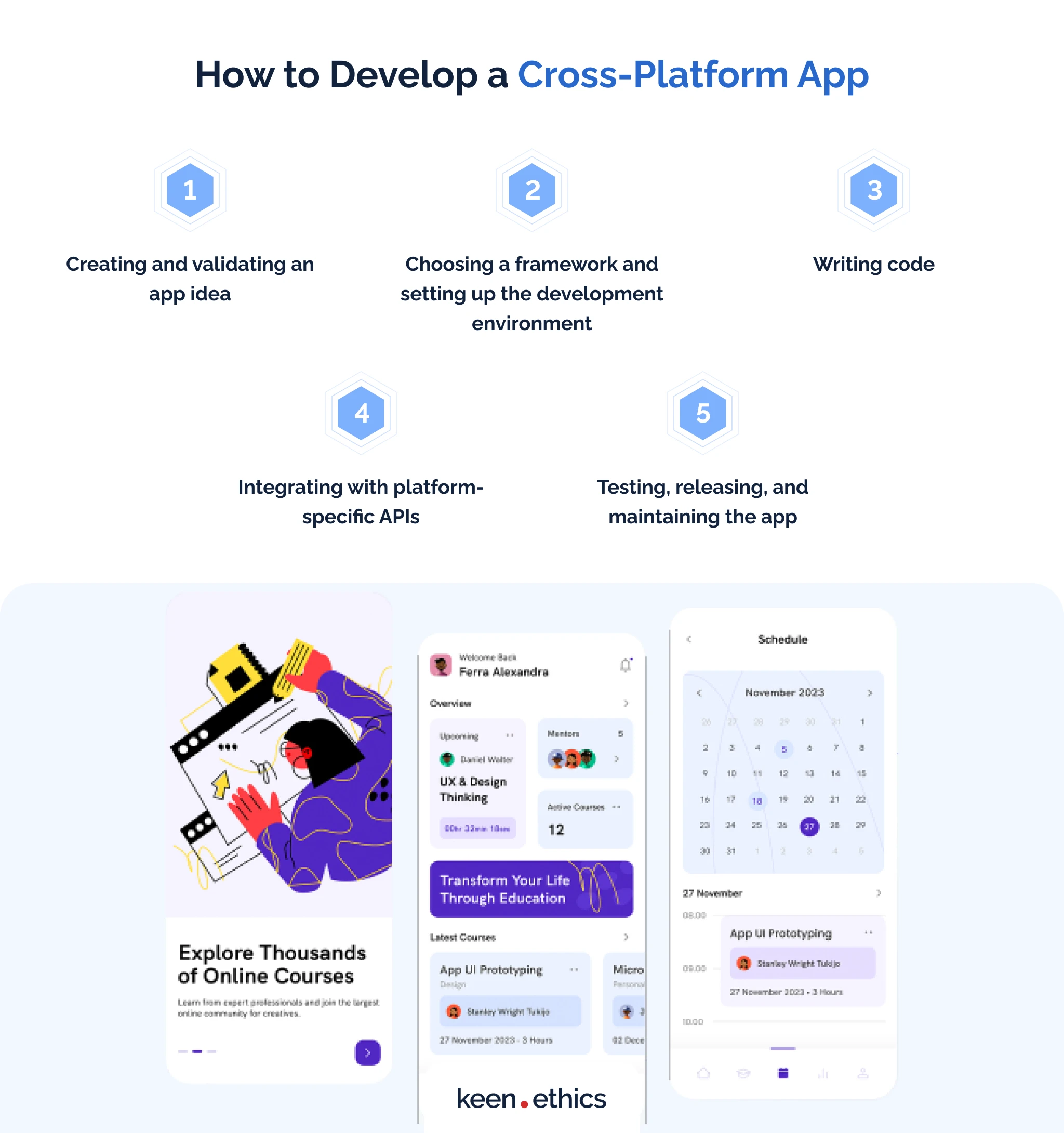
So, do you want to invest in cross-platform development tools? Let’s look at the key steps you should consider during development:
1) Creating and validating an app idea
The first step in any development process is coming up with an idea for an app. In this respect, you should look at the market and find some gaps. For example, Virtual Reality workspaces are a promising field in the current conditions. Another step is idea validation. Not all ideas are feasible technologically or socially. Who can help with the second step? You should address professionals who work with many projects on the market. We at Keenethics can help you with this aspect: contact us for high-quality feedback and an estimate of your project cost.
2) Choosing a framework and setting up the development environment
Understanding what platform will cover your needs is a big aspect of any app development process. In this regard, you may like Titanium SDK and Node.js, for example. Once you choose, it’s time to set up the development environment. What does this imply? One should review the existing modules for the presented platforms and decide what tools are necessary for creating a high-quality app.
3) Writing code
With the development environment in place, the best choice is to start coding. Here, we have nothing to add: if you have everything pre-planned, your developers will simply have to follow a set of tasks to deliver a strong product.
4) Integrating with platform-specific APIs
Once you’ve finished developing the core code of your app, it’s time to consider integration with diverging platforms. iOS and Android have unique APIs requiring code integration to function well. Modern cross-platform apps integrate well with them, but one still needs to be careful.
5) Testing, releasing, and maintaining the app
Upon finishing the main development process, it’s time to test the code for errors and minimize the bugs. After the app becomes robust enough, release it, and maintain the software to remove any remaining problems.
How to Test and Debug a Cross-Platform App
Cross-platform app testing is among the key development processes. Why? It ensures a higher level of security and the best user experience possible. As TechTarget, a major technology publication, notes, big problems with software such as operating systems and even video games are becoming so common due to the lack of testing. Many developers target velocity over quality, with clients suffering as a result.
Positive testing practices
So, what are the examples of positive testing techniques? Here are some practices you should consider:
1) Unit Testing: unit testing focuses on testing individual code units, such as functions or methods, in isolation. It helps identify bugs or issues at an early stage and ensures the individual components of the app work as expected.
2) Integration Testing: integration testing verifies the interaction between different components or modules of an app. It tests how these components cooperate and if they communicate correctly. What’s the difference between unit and integration testing? If unit testing reviews the functions of the individual elements, integration testing goes for the interaction between those units. Unit testing reviews how parts of an app work. Integration testing views the larger scale, the long-term functioning of an app itself.
3) UI Testing: UI testing, also known as end-to-end testing, focuses on validating the user interface and user interactions. It involves simulating user actions and verifying that the UI elements and functionality work correctly across different platforms or devices. Why is it so important? UI testing can help find issues that push the users away from utilizing your app in everyday scenarios. We at Keenethics pay special attention to such testing. You can address our company to perform a full-scale UI/UX audit of your product.
Related Services
UI/UX DESIGN AND DEVELOPMENT SERVICES
Examples of Software for Testing (Titanium SDK)
Many apps for testing exist on the market. Since we have extensive experience with this platform, we will look at the options available to Titanium SDK users here.
1) Ti-mocha: this testing platform is an adaptation of Mocha for Titanium SDK. The framework has few defaults, making it perfect for those who like customization. You’re free to choose if you want to connect libraries such as should.js and assert.js. When you seek flexibility, Ti-mocha is the best framework on the market.
2) Tishadow: Tishadow is a Titanium-specific testing app. Apart from testing tools, it offers great deployment capabilities. Its basis is Jasmine, from which it inherits both positives (simplicity) and negatives (limited assertion capabilities). What’s the reason to use Tishadow over Titanium Jasmine? Tishadow receives constant updates, improving the long-term usability of the relevant solution.
3) Ticalabash: Ticalabash is an adapted version of Calabash for automated testing of apps for mobile platforms. The main benefit of this open-source framework is its focus on the BDD (Behavior-Driven Development) solution named Cucumber. It allows the specialists to outline tests in a language that’s close to natural (rather than the arcane code of traditional scripting languages). Still, it’s not without problems: the platform is unstable.
How to Release and Deploy a Cross-Platform App
Releasing and deploying are the key steps to consider after cross-platform mobile app testing. So, what should you do? Here are the key steps in the development process:
- Review the app store guidelines and submission requirements to adapt to them. All major app stores have clear rules. You should review them and adapt your app to these requirements. In this respect, we recommend considering this aspect as early as possible in the development process. The earlier you adapt to diverging rules, the better.
- Sign your app. Once you get the approval of the platform owners, it’s time to insert signatures into your apps. Why are they important? Using the signatures, app platforms can check the integrity of your software and maximize security for the users.
- Generate a release build and submit it for review. With signatures in place, we recommend compiling the final version of your app and sending it to Android or iOS experts for review. If you do everything according to the platform rules, it’s unlikely that some large-scale changes will be necessary after these steps.
Maintenance and How to Produce Updates for Your Apps
The final step to consider if you want to build a cross-platform mobile app is post-release maintenance. In essence, the app testing cycle doesn’t stop after release. Immersed in real-life situations encountered by the users, it’ll likely produce many unexpected bugs. In this light, regular app updates are essential at this stage. What to do at this point? You should collect bug reports, classify them according to severity, and then produce bug fixes in patches. A big issue may require a new release fast. Something smaller can wait for some large-scale patch fixing a multitude of problems. The same approach also concerns the new features. You should collect feedback and study analytics to understand what clients need. Features that can be a dealbreaker for the users should be added fast. Something smaller, once again, can wait for a major release. We heavily recommend collecting as much information as possible about user behavior through internal analytical tools and surveys. The more you know, the higher the chance of creating a potent app.
Conclusion
To summarize, cross-platform app development is among the most promising fields in the current market. Why? It simplifies the app development and lowers the relevant costs despite bringing about no major damage to the long-term productivity of the software (of course, if the developers are talented and experienced enough). We’ve also reviewed cross-platform testing. As you can see, there are many options for those who want to debug their products. In this respect, we recommend experimenting with different tools. The more you try, the higher the chance you’ll understand your development needs well. If you’re interested in professional help with choosing high-quality platforms for development and testing, don’t hesitate to address Keenethics. We have more than eight years of experience in creating cross-platform apps.
Address Keenethics to get a free estimate of your project costs.



